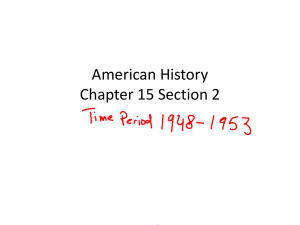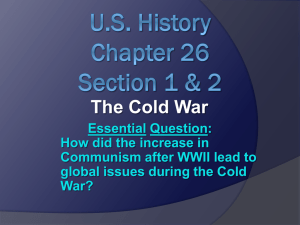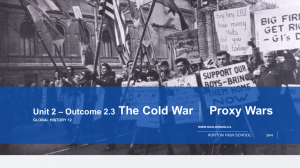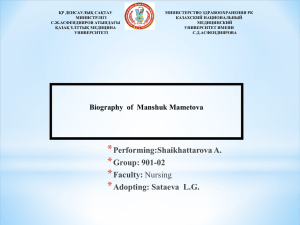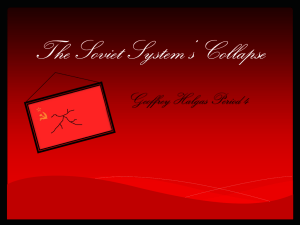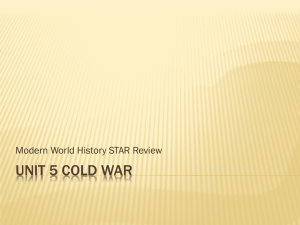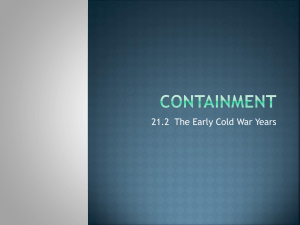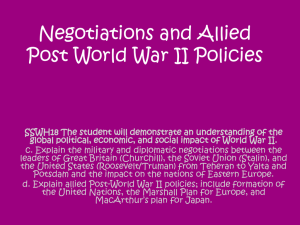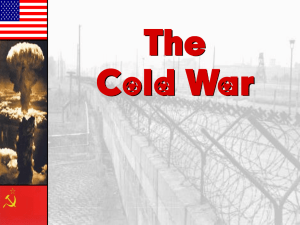The Cold War: A World Divided
advertisement
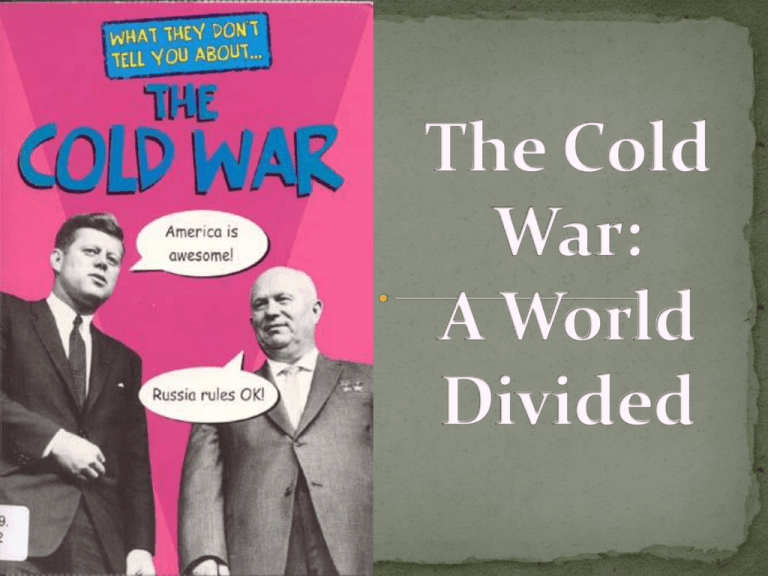
Relationship b/w U.S. & Soviet Union was shaky before WWII even ended U.S. was upset Stalin signed non-aggression pact Stalin blamed Allies for not invading sooner Yalta Conference-February 1945 Churchill, FDR, Stalin agree to: decide to divide Germany into zones of occupation controlled by military forces (American, Soviet, British, French) Germany to pay war reparations to Soviet Union Soviet Union to join war against Japan Stalin promises Eastern Europeans would have free elections 1946 United Nations is created, headquarters NYC 50 countries join international organization to protect members from war Security Council: 11 rotating members, 5 permanent (U.S., Britain, France, Soviet Union, China) have veto power WWII-U.S. lost 400,000, cities were not damaged, richest & most powerful Encourage democracy Rebuild European gov’ts to bring stability & new markets for American goods $$$ Reunite & stabilize Germany, make Europe more secure Gain raw materials WWII-Soviet Union lost 20 million (1 in 4 Soviets were killed/wounded), cities destroyed Encourage communism (promote worldwide workers’ revolution) Rebuild the economy destroyed by war using Eastern European industry & raw materials Control Eastern Europe to protect Soviet borders & balance out the U.S. influence in Western Europe Keep Germany divided to prevent it from ever starting another war Represents Europe’s division into Democratic Western Europe & Communist Eastern Europe Russians were tired of being invaded (centuries of invasion-Poles, Swedes, Napoleon, Germany twice) Create buffer (wall of protection) along Russia’s western border turns those countries communist (Poland, Romania, Czechoslovakia, Hungary, Yugoslavia, Bulgaria, Albania) Potsdam Conference- 1945 Truman, Stalin, Churchill Stalin refuses to allow free elections, says communism & capitalism cannot exist in same world Germany is divided in half-east & west at Berlin A peep under the iron curtain Containment U.S. policy to stop Soviet influence & communism from expanding Form alliances and help weak countries resist communism Truman Doctrine Truman announces the U.S. will give economic & military aid for countries to resist communism Controversial…should U.S. interfere in the affairs of other countries? $400 million to Greece & Turkey Western Europe in ruins after WWII Not enough jobs or food U.S. Secretary of State George Marshall proposed an assistance program Provide food, machines, materials to rebuild Western Europe Huge success After World War II, Germany was divided into four zones, occupied by French, British, American, and Soviet troops. Occupation zones after 1945. Berlin is the multinational area within the Soviet zone. Soviet blockade: East Berlin West Germany East Germany West Berlin · In June of 1948, the French, British and American zones were joined into the nation of West Germany after the Soviets refused to end their occupation of Germany. Berlin Airlift 1948 U.S., Britain, France decide to withdraw troops from Germany Soviet Union wanted Germany kept weak & divided responded by taking West Berlin hostage city faced starvation Allies flew food & supplies into West Berlin for 11 months Germany remains divided: · In May of 1949, Joseph Stalin of the Soviet Union ended the blockade. · The Soviet zone of Germany, including East Berlin, became known as the nation of East Germany. October, 1949 Cold War Struggle over political differences carried on without using war Lasted over 40 yrs b/w U.S. & Soviet Union NATO=North Atlantic Treaty Organization 1949 10 Western European countries joined U.S. & Canada to form military alliance Attack on any NATO member is an attack on all Warsaw Pact 1955 Formed as response to NATO Alliance of Soviet Union, East Germany, Czechoslovakia, Poland, Hungary, Romania, Bulgaria, Albania Built Berlin Wall to separate East & West Berlin Symbol of the world divided The Korean War 1950-1953 At end of WWII, Japanese troops surrendered 38th parallel line Korea is split into 2 nations North Korea communist, supported by Soviets South Korea democratic, supported by West Soviets supply NKorea w/ tanks, airplanes, $$$ to take over entire peninsula Truman’s policy of containment is put to the test June 25, 1950 North Invasion Korea invades South Korea Takes over entire peninsula except Pusan (p543) UN sends in international peacekeeping forces to help South Korea (soldiers from 15 nations, 80% U.S.) Leader: General Douglas MacArthur Here comes China Sept. 1950 MacArthur leads UN invasion of Korea Pushes NKoreans back to Chinese border Chinese feel threatened & sends in 300,000 troops Push UN & SKorean troops out of NKorea & capture Seoul (capital South Korea) MacArthur calls for nuclear attack against China Truman sees this as reckless “We are trying to prevent a world war, not start one.” MacArthur won’t let up & is removed 1953 UN regains control of SKorea Aftermath of Korean War July 1953 UN & NKorean forces sign ceasefire, agree to border at 38th parallel (same as before war) 4 million soldiers & civilians dead N&S Korea still divided today Communist NKorea established collective farms, build up military Kim Jong Il built up nuclear weapons, serious economic problems South Korea prospered (w/ U.S. help) Huge foreign trade & economic growth The Nuclear Threat U.S. had atomic bombs 1949 Soviet Union exploded its own atomic weapon 1950 Truman responded by working on Hydrogen Bomb (thousands xs stronger than a-bomb) 1952 U.S. tests H-Bomb 1953 Soviets test H-Bomb “brinkmanship-”willingness to go to the brink (edge) of war (retaliate for any attack) Need nuclear weapons & planes to carry out CUBAN MISSILE CRISIS=brinkmanship The World is Divided 1st world=United States & allies 2nd world=Soviet Union & allies 3rd world=developing nations, not aligned with either Located in Latin America, Africa, Asia Poor, politically unstable (colonialism) Fidel Castro’s Cuba 1950s Cuba backed by U.S., unpopular dictator Fidel Castro leads revolution & becomes dictator Suspends elections, jails & executes opponents, controls media, took over economy Turns to Soviet Union more economic & military aid U.S. tries to invade Cuba (Bay of Pigs)…disaster Soviets respond by placing nuclear missiles in Cuba (90 miles from U.S.) Read The Cuban Missile Crisis & answer questions Major Strategies Foreign Aid Both superpowers gave $ to countries to influence & win allies Propaganda Both used to win support Espionage Spies were sent into both sides, U-2 spy planes, etc. Brinkmanship Going to the brink of war to get the other to back down Ex: Cuban Missile Crisis Alliances NATO, Warsaw Pact Surrogate (substitute) Wars Korea, Vietnam Uprisings in Poland, Hungary, & Czechoslovakia Hungary 1956 anti-communist revolt, new gov’t & leader Soviet troops crush uprising & execute leader (Nagy) Czechoslovakia 1968 communist leader Dubcek begins reforms during “Prague Spring” End censorship, allow criticism of gov’t Soviets invade country, reverse reforms, kick him out of party Détente & SALT Détente: lessening of Cold War tensions After Vietnam War, U.S. backed away from direct confrontation w/ Soviet Union President visits China & Soviet Union SALT=Strategic Arms Limitation Talks Nixon & Soviet leader Brezhnev sign treaty limiting the number of missiles in both countries Falls apart during late 1970s-1980s under Carter & Reagan
